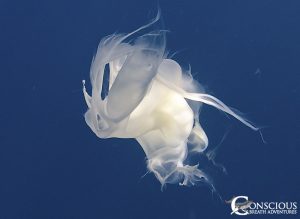- Welcome to Conscious Breath Adventures
Eight things you should know about mother humpback whales
- Home
- Humpback Whales
- Fun Facts About Mother Humpback Whales
Happy Mother’s Day from the Silver Bank!
As all moms know, giving birth and those first months in a newborn’s life is a profoundly intense and special time. For staff and guests of Conscious Breath Adventures, our place as quiet observers of humpback whales during this period is an honor. We don’t take it lightly.
In celebration of mother humpback whales this Mother’s Day, we’re sharing some science snippets that all ocean lovers should know.
1. Humpback whales do not have periods
Lucky things! But like all mammals they do have estrus cycles, i.e they ovulate. They have even been found to synchronize the timing of those cycles.
2. But, they are pregnant for nearly a year
Females reach sexual maturity at 6-8 years of age. For the North Atlantic humpbacks, their typical reproductive life history starts with getting pregnant in the Caribbean. While no one has seen mating happen, we are surrounded by their courtship behavior every day on the Silver Bank.
In the spring they travel north for the summer to feed. They’ll grow their baby inside and fatten themselves up before migrating back to the Caribbean to give birth. Their gestation period is a little less than a year.
3. Their babies are BIG
 Calves are 12- 15 feet long at birth and weigh around a ton. They are whales after all but considering an adult female averages 40 feet and 40 tons that’s still a big baby! They are around a third of their mother’s body length at birth, if just a fraction of their weight.
Calves are 12- 15 feet long at birth and weigh around a ton. They are whales after all but considering an adult female averages 40 feet and 40 tons that’s still a big baby! They are around a third of their mother’s body length at birth, if just a fraction of their weight.
It is thought that they are positively buoyant and can swim at birth but are helped to the surface for their first breath. Calves enter the world tail first and the placenta easily dislodges and floats away.
Newborn calves seen on the Silver Bank are a very pale, soft gray in color, darkening up within days as the melanin develops in their skin. They get a tan! We still don’t know much about the actual birth event for humpbacks on the Silver Bank. Does it take place at night? Are the females alone? How long is their labor? The birth process is one of the big mysteries of the humpback world.
4. But there’s only one of them
Humpbacks are uniparous, in other words they give birth to just one baby at a time. Twins in cetaceans can happen but are very rare, occurring in less than 1% of births.
5. Thank goodness, as they need a lot of milk
 Nursing calves drink around 50 gallons of milk per day. It is amazing to witness a baby humpback nursing. With 50% fat content, five times that of human breast milk, the rich milk is incredibly nutritious. Calves do not ‘latch on’ and suckle like terrestrial mammals. Female humpbacks have musculature in their mammary glands that allows them to squirt the thick, viscous milk into the hungry calf’s mouth.
Nursing calves drink around 50 gallons of milk per day. It is amazing to witness a baby humpback nursing. With 50% fat content, five times that of human breast milk, the rich milk is incredibly nutritious. Calves do not ‘latch on’ and suckle like terrestrial mammals. Female humpbacks have musculature in their mammary glands that allows them to squirt the thick, viscous milk into the hungry calf’s mouth.
6. All that milk comes from their blubber
Humpback whales do not feed during the months they are on the breeding grounds. That means that the fifty gallons of milk a day comes from the mother’s blubber stores. It takes a lot of blubber to create fifty gallons of milk. A mother humpback whale can lose up to one third of her body weight until she feeds again.
The incredibly high energy demands of pregnancy and lactation at a time of prolonged fast is just one of the many reasons whale watching on the Silver Bank is carried out with the utmost sensitivity to the animals.
7. Moms have a lasting influence
Genetic studies undertaken in recent years have shown that groups of whales observed associating on feeding grounds are in fact related through the maternal line.
Like most baby animals, humpbacks learn how to feed from their parents. It makes sense and has been born out in the lab – mothers pass on their lessons on feeding to their calves. That means these small groups of possibly half siblings or cousins were reading from the same genetic and experiential textbooks, so to speak. Many fascinating questions still remain. How are they communicating with each other? How closely are the groups related and working together?
8. Single mothers rock
Male humpback whales play no part in upbringing. Perhaps no surprises there…
A Toast to the Mommas!
 The entire reproductive cycle of the female humpback whale is an amazing thing to consider. Between the fact that they are fasting, the length of their gestation, the nature of their milk and nursing, and all the care and nurturing that happens until the calf breaks out on its own (click image to watch a mother humpback play with her calf). All these details are just some of the things that make humpback whales so fascinating. The males play their part, sure, but it’s Mother’s Day so today we give our love and appreciation to these big beloved mommas!
The entire reproductive cycle of the female humpback whale is an amazing thing to consider. Between the fact that they are fasting, the length of their gestation, the nature of their milk and nursing, and all the care and nurturing that happens until the calf breaks out on its own (click image to watch a mother humpback play with her calf). All these details are just some of the things that make humpback whales so fascinating. The males play their part, sure, but it’s Mother’s Day so today we give our love and appreciation to these big beloved mommas!